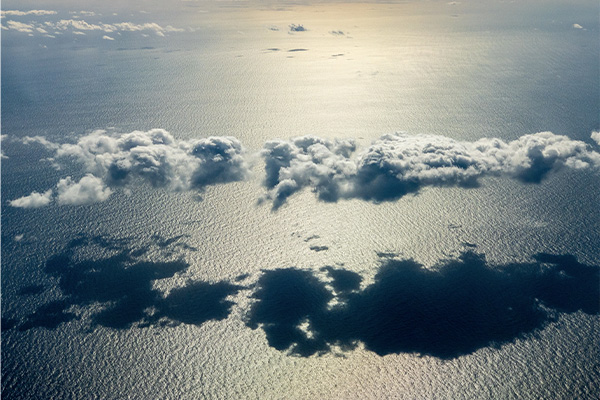Scientists find new way global air churn makes particles
Wang’s atmospheric science and engineering lab discovers new mechanism of particle formation when stratosphere, troposphere air mix

You can think of our atmosphere as a big chemistry set, a global churn of gaseous molecules and particles that constantly bounce off and change each other in complicated ways. While the particles are very small, often less than 1% of the thickness of human hair, they have outsized impacts. For example, particles are the seeds of cloud droplets, and the abundance of the particles changes the reflectivity and the amount of clouds, rainfall and climate.
Now, researchers at Washington University in St. Louis have discovered something new in the sky, a mechanism that produces a large portion of particles in Earth’s atmosphere.
The research, published in Science this month was led by Jian Wang, professor and director of the Center for Aerosol Science and Engineering at WashU. The research team includes Lu Xu, assistant professor in WashU’s Department of Energy, Environmental & Chemical Engineering at the McKelvey School of Engineering and scientists from NASA, NOAA, NCAR and European universities.
The conventional thinking was that most particle formation occurs in cloud outflow regions, where clouds float into the upper troposphere and eventually evaporate. In that process, clouds are getting wrung out and most particles are removed by rain. As a result, the air in the outflow regions is clear and clean, leaving some gaseous molecules with nowhere to go but form new particles.
“However, using the data collected from NASA’s global-scale aircraft measurements, we found that most of the new particles are not formed in the outflow regions as previously thought,” Wang said.
While puzzling over this surprising observation, Wang and colleagues ended up discovering a whole different mechanism taking place when the mixing of stratospheric and tropospheric air results in conditions that are ripe for particle formation.
“Stratosphere air often dips in troposphere due to meandering jet stream. As the ozone-rich stratospheric air and more moist tropospheric air mix, it leads to a high concentration of hydroxyl radical (OH), an important oxidant that helps produce the type of molecules that nucleate and form new particles,” said Jiaoshi Zhang, first author on the study and a research scientist in Wang’s lab.
“We found this phenomenon is widespread around the globe and likely occurs more frequently than the particle formation in the cloud outflows,” he added.
Future field observations and modeling studies will be needed to confirm and further quantify the importance of this newly discovered mechanism of particle formation. Obviously, humans contribute their own particles in the form of air pollution, but Wang said what was discovered in this research is a natural process that occurs around the globe, even in remote and pristine regions.
There is also some evidence that stratospheric air will dip into troposphere more frequently in future climate, so this mechanism may become even more important, Wang said. Including this previously unknown process can improve climate models and may help better simulate climate change and predict future climate.
“While we were puzzled by the observation initially, once we put everything together, afterwards it was not so surprising,” Wang said. “It is well known that molecules forming new particles are generated through oxidation in the atmosphere. When the stratosphere and troposphere air mix, the OH concentration is very high, and it’s primed for particle formation.”
Zhang J, Gong X, Crosbie E, Diskin G, Froyd K, Hall S, Kupc A, Moore R, Peischl J, Rollins A, Schwarz J, Shook M, Thompson C, Ullmann K, Williamson C, Wisthaler A, Xu L, Ziemba L, Brock CA, Wang J. Stratospheric Air Intrusions Promote Global-Scale New Particle Formation. Science 385, 210-216 (2024). DOI: https://doi.org/10.1126/science.adn2961
J.W., J.Z., and X.G. were supported by the National Science Foundation (NSF) Division of Atmospheric and Geospace Sciences (grant no. AGS-2147747) and NASA Radiation Sciences Program (grant no. 80NSSC19K0618). K.F., A.K., J.P., A.R., J.S., C.T., C.W., and C.B. were supported by NASA’s Earth System Science Pathfinder Program (grant no. NNH15AB12I) and by NOAA’s Health of the Atmosphere and Atmospheric Chemistry, Carbon Cycle, and Climate (AC4) Programs. K.F., J.P., C.T., and C.W. were also supported in part by NOAA cooperative agreements (grant no. NA17OAR4320101 and NA22OAR4320151). A.K. was supported by the Austrian Science Fund FWF’s Erwin Schrodinger Fellowship (grant no. J-3613). This work was also supported by NASA under awards NNX15AJ23G, NNX15AH33A, NNH13ZDA001N, NNX15AT90G, NNX15AG71A, 80NSSC19K0124, and 80NSSC18K0630



